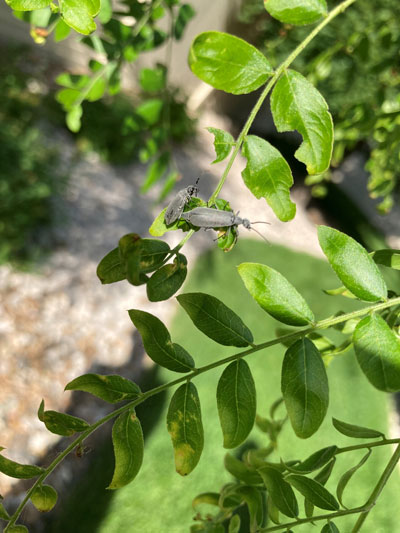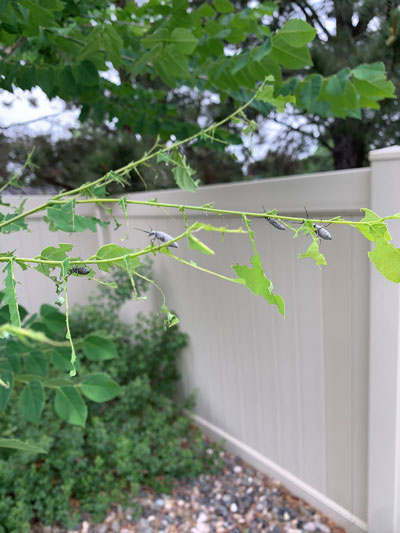Blister Beetles in the Yard and Garden
Blister beetles have been aggregating and causing defoliation on trees and shrubs in yards and gardens. Some of the more common species present are those in the genus Epicauta.
Blister beetles in the genus Epicauta lay eggs in areas surrounding grasshopper eggs. The immature stage (larvae) will feed on these grasshopper eggs.
Damage
The adults chew leaves and foliage. They also can leave some fecal spots. They will feed together in large groups and can defoliate plants. They are called “blister beetles” because they have a defensive oil called cantharidin that can cause blistering. The blister beetle species in gardens have very low amounts of the cantharidin.

Pair of gray blister beetles feeding on a honeylocust tree. Photo by Maggie Joy. Larger image (4.3MB)

Damage from blister beetles, most of the leaves have been chewed off. Photo by Maggie Joy. Larger image (3.5MB)
Management
Blister beetle infestations are temporary and generally only last for a few days. The damage rarely causes economic hardship to established or older trees. Management is often not necessary in these situations.
If chemical control becomes necessary, some active ingredients for adult blister beetle control for woody ornamentals include pyrethrins, carbaryl (products such as Sevin, Bonide Fruit Tree Spray, Bayer Complete Insect Killer for Gardens), and pyrethroids (active ingredients zeta-cypermethrin, gamma-cyhalothrin and lambda-cyhalothrin-some example products include Safer Yard & Garden Insect Killer II Ready-to-Use, Ortho Tree and Shrub Fruit Tree Spray, Ortho Home Defense Max Insect Killer for Lawns & Gardens Ready-to-Spray).
Please note: These recommendations are not intended for crops or rangeland.
Further Information
To learn more about the topics discussed on this page, contact the Schutter Diagnostic Lab. If you suspect an infestation on your property, contact your local extension agent, the Schutter Diagnostic Lab at Montana State University, or the Montana Department of Agriculture.
This July 2021 fact sheet is also available as a Printable PDF (539KB).
Disclaimer: These recommendations are provided only as a guide. It is always the pesticide applicator’s responsibility, by law, to read and follow all current label directions for the specific pesticide being used. The authors and Montana State University assume no liability resulting from the use of these recommendations. The Montana State University Extension Service is an ADA/EO/AA/Veteran’s Preference Employer and Provider of Educational Outreach.
